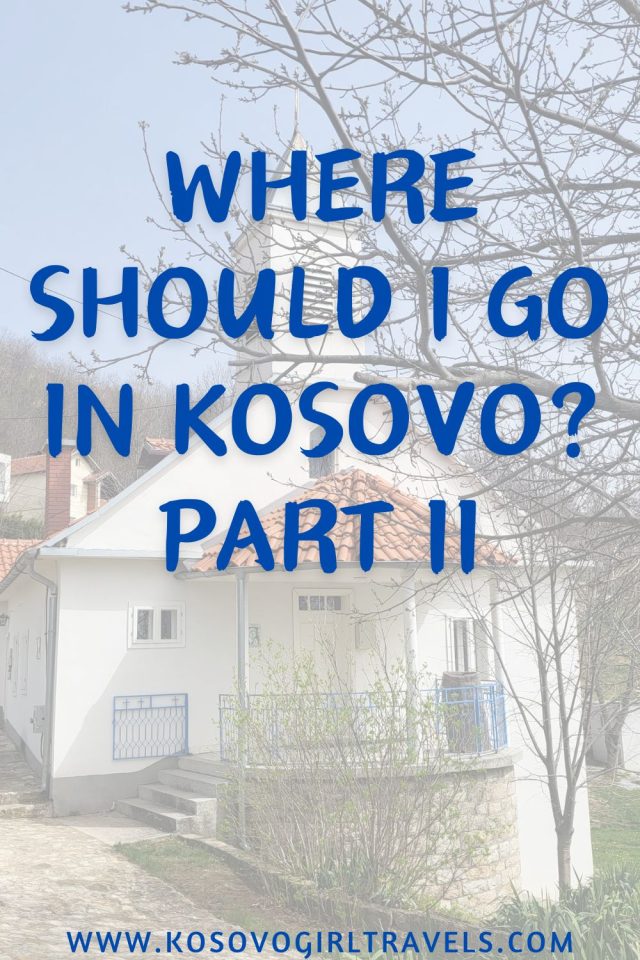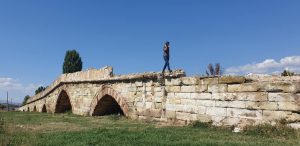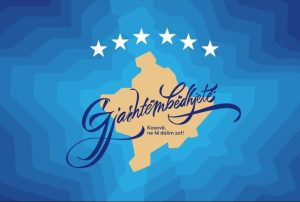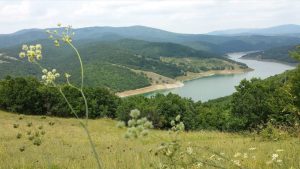
I know many of you have wanted to read the second part of Exploring Kosovo beyond the 3 Ps so you can learn how to explore Kosovo cities; therefore, here it goes!
Kamenica
Situated in the eastern part of Kosovo, Kamenica is a town exuding charm and history. It is not known to tourists or even locals that much. Nevertheless, it is a great place for hiking as told by a foreigner who made it its own home. Additionally, Kamenica has a fort that can be visited and offers some nice views. In the surrounding villages, Kamenica has several good spots for hiking and resting, a horse ranch with beautiful views, and a chance to do horseback riding for a small fee.
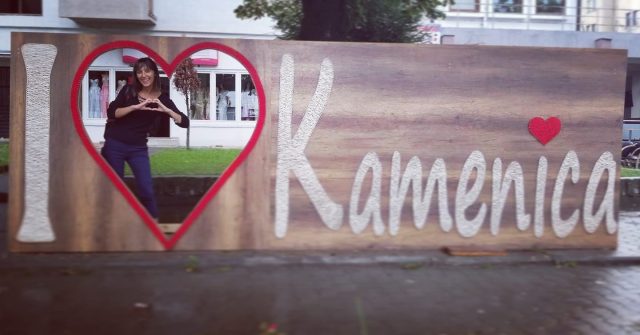
Klina
Klina is located in the western part of Kosovo. Often overlooked in the region due to Peja offering Rugova Gorge and mountains and Istog nearby offering fresh trouts, Klina is a small town with an old history with sites like Gllareva dating back to the Late Bronze Age or the archaeological site of Dresnik, dating from the Roman period, offers a blend of natural beauty and cultural heritage. Surrounded by stunning mountains and vast fields, the city is a paradise for outdoor enthusiasts. Embark on hiking trails that lead to breathtaking viewpoints, where you can soak in panoramic vistas of the picturesque landscape. Additionally, Klinë boasts several historical sites, such as the ancient ruins of Vicianum, and provides glimpses into the region’s rich history.
Kllokot
Kllokot is a new municipality that came as a result of the decentralization process. It is a village turned into a town. The main attraction is the thermal bath “Banja e Kllokotit” which serves also as a facility for medical and therapeutical services. An important site in this town is the Vërban archaeological site where a statue of a Dardanian woman was discovered.
Leposaviç
Leposaviç is located in the north of Kosova, on the border with Serbia (fun fact: I haven’t been there yet). There are religious sites such as monasteries and churches as well as archaeological sites like the one of Municipium D.D. in the village of Socanica, which primarily existed as a prehistoric settlement and changed into a Roman town.
Lipjan
Lipjan is only about 16km far from the capital city. The most famous attraction of this town is, no doubt, Gadime Cave, also known as the Marble Cave. It was discovered in 1969 and it is full of crystallized stalagmites and stalactites that have formed over millions of years. The tour takes about 30 minutes during which one can hear the history of how it was discovered as well as make out the figures created. It is easily reachable by buses that leave very often from Prishtina Bus Station.
Malisheva
Malisheva is another little town that gets neglected often. However, the Mirusha River with its waterfalls is something that can be visited while in the area along with the cave in the village of Panorc. Another cave has been discovered in another village of Malisheva though hasn’t been explored fully. in Banja village, visitors can also use the thermal bath which is known for curing skin diseases but also the pool which is used during summer for sports activities as well.
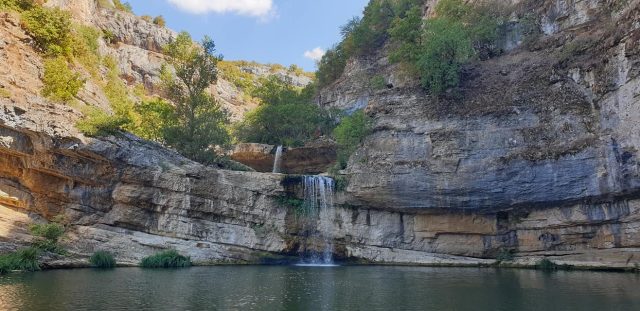
Mamusha
Mamusha is a small municipality, in the region of Prizren, established in 2008 as a result of the decentralization process. The majority of the population is of Turkish ethnicity. It is mostly an agricultural/rural area with not many tourist attractions to offer. However, if you are looking for fresh, organic produce, you can get it here.
Mitrovica
Divided by the Ibër River, Mitrovica is a city of contrasts that reflects Kosovo’s complex history. The northern part of the city is predominantly inhabited by the Serbian community, while the southern part is mainly home to the Albanian community. Despite the division, Mitrovica offers unique experiences that bridge cultures. Explore the lively city center, visit the iconic Ibar Bridge that connects the two sides, and engage in conversations with locals to gain a deeper understanding of the region’s history and challenges.
North Mitrovica
A new municipality was established due to political reasons, and because of the Ibër River, it was easier for the city to be divided following the war of 1998/99. The famous Monument of the Fallen Miners is now located in the northern part of town and it is one of the main reasons why someone would cross the bridge along with being made to “feel like you’re in Serbia” due to the flags and graffiti used by the locals who still refuse the new reality of Kosovo being independent.
Novobërdë
Novobërdë, known as well as Artanë, is situated in western Kosovo and is a city rich in cultural and historical heritage. Discover the enchanting Novobërdë Castle, which dates back to the 13th century, and marvel at its imposing architecture and panoramic views. Novobërdë also offers opportunities for outdoor activities, such as hiking.
Obiliq
Known mainly for the power plants, Obiliq is mostly forgotten by locals as well. There isn’t much to see there or do, but maybe you can still find something and let me know what was in the comments!
Partesh
A former village turned into a municipality due to the decentralization process that took place in Kosovo.
Podujevë
Podujevë, known as Besianë as well, is located in the northeastern part of Kosovo, only 35 km away from the capital. The most known attraction is Batllava Lake, which is actually a reservoir but very useful not only for summer activities but also for water supply for the capital and Podujeva itself. There are also mills which used to serve the local population made of wood. One of them is Demë Ahmeti Mill in Recica village. Another place to visit is the “Zahir Pajaziti Memorial Complex” which hosts the grave and statue of this KLA Commander who fought in the last Kosova war in 1998/99.
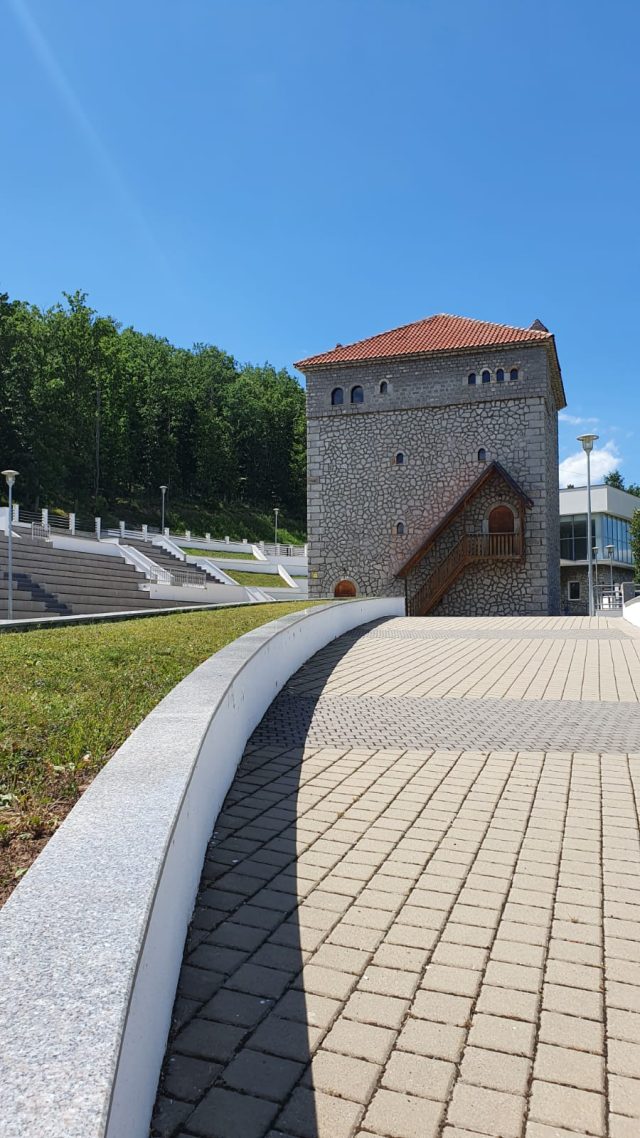
Rahovec
Rahovec is a charming city renowned for its vineyards and winemaking traditions. Embark on a wine tour to explore the region’s vineyards, where you can learn about the winemaking process and sample a variety of exquisite local wines. One of the best times to go there is early September when the Hardh Fest festival takes place.
Ranillug
Ranillug is another village that turned into a municipality as a result of the decentralization process in Kosovo.
Shtërpcë
Shtërpcë, located in the southern part of Kosovo hosts one of the main ski resorts in Kosovo, Brezovica. Many locals but also foreigners visit Brezovica in winter so they can enjoy winter sports at a cheap price; however, Brezovica is a place to visit also during the other seasons.
Shtime
Shtime is a small municipality close to Prishtina. In the surroundings of Shtime is the village of Reçak where a massacre that happened in January 1999 made the international actors aware of the ethnic cleansing and genocide that was about to take place in Kosovo thus bringing attention to the war in Kosovo. However, Shtime also hosts some cool places that I visited some time back, such as a lovely pine park, a lovely restaurant, and very hospitable people.
Skënderaj
Skënderaj is one of the most important locations when it comes to recent Kosovo history, namely the last Kosovo war, Prekaz is one of the places where probably every Albanian from Kosovo has gone at least once. It is in Prekaz where more than 50 members of the family of Adem Jashari were killed fighting against Yugoslav military forces for our freedom. Only one survivor, Besarta, made it alive from the three days of fighting. Today, their house and the graves are turned into a memorial site.
Additionally, in Runik, a village of Skënderaj, a neolithic settlement was investigated from 1966-68 and again in 1984.
located in western Kosovo, offers a blend of natural beauty and historical significance. Explore the scenic surroundings by venturing into the nearby countryside, where you can discover hidden trails, charming villages, and panoramic vistas. The city is also known for its historical landmarks, such as the Skënderbeu Castle, which stands as a testament to the region’s medieval past. Immerse yourself in Skënderaj’s rich history, admire its architectural gems, and connect with the welcoming local community.
Suharekë
Suharekë, located in the southwestern part of Kosovo, is another known city in Kosovo for wine-making. Lately, they are also known for their football club, Ballkani. Other options for spending time there are also restaurants in rural areas with breathtaking views.
Viti
Viti, situated in eastern Kosovo, isn’t given enough credit by either locals or visitors. However, Viti has two important villages in its area: Letnica and Stublla. Letnica is the village where Saint Mother Teresa got her call for service and Stublla is the village where the first school in the Albanian language operated. The school now is a museum which can be visited for free and where everyone can learn a lot, not only about the school but also about the history of that area.
Vushtrri
Vushtrri, located in the northern part of Kosovo, is a city known for its historical significance and architectural treasures. Explore the old fortress and hamam in the city center, as well as the old stone bridge.
Zubin Potok
Zubin Potok, situated in northern Kosovo, is a city known for its pristine natural beauty and outdoor recreational opportunities. Embark on hiking trails that lead you through lush forests, tranquil meadows, and picturesque landscapes. The nearby Bistrica River offers excellent fishing spots and idyllic picnic areas. For history enthusiasts, a visit to the impressive Visoki Dečani Monastery is a must. This UNESCO World Heritage site showcases stunning medieval frescoes and provides a serene setting for contemplation.
Zveçan
The most important tourist attraction in Zveçan is the Kulla e Isa Boletinit (the stone house of Isa Boletin). Isa Boletini was a fighter for the unification of Kosova and Albania. In 1912, when Albania declared its independence, Boletini was on his way to Vlora to join it but couldn’t make it in time due to fighting along the way. He remains one of the main characters of the Albanian history. Other than that, there are two neolithic sites to visit: the one of Zhitkoc and Karagaç of Vinca culture.
PIN IT!
